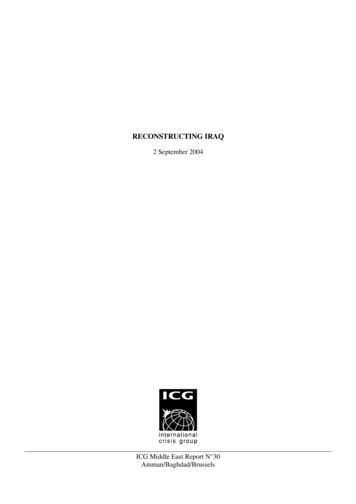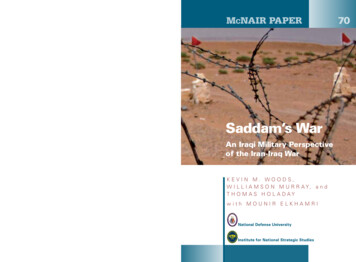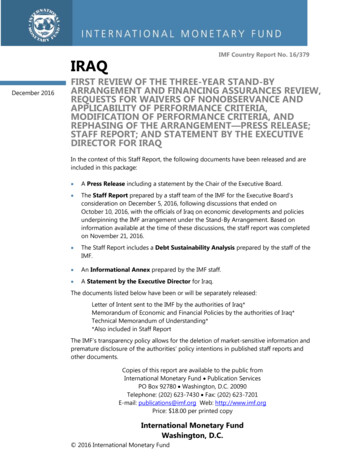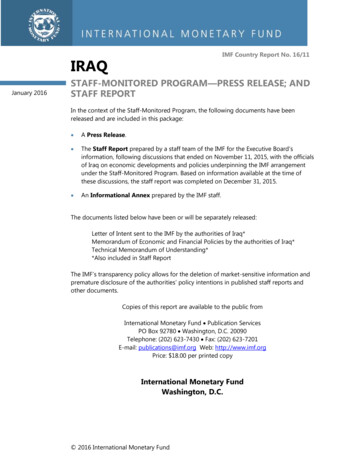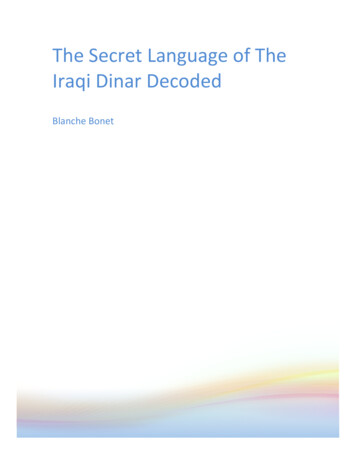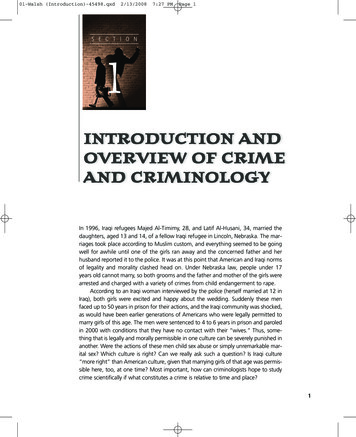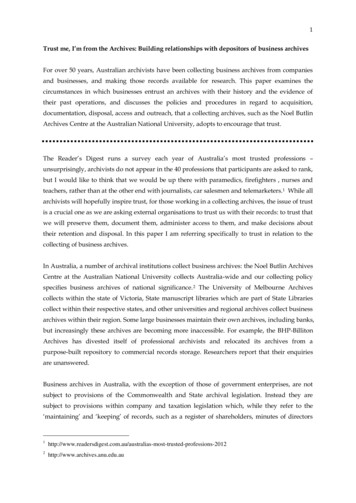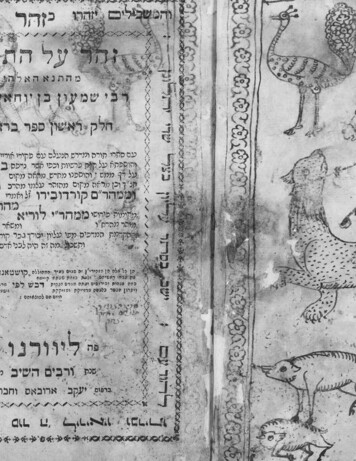
Transcription
Preservingthe “IraqiJewish Archive”By Doris A. Hamburg and Mary Lynn RitzenthalerOne of the rewards of our work at theNational Archives in preserving therecords of the federal government comesfrom learning the fascinating human sto ries that relate to the records.This is the story of how the Na tional Archives Preservation Pro grams staff was called upon torescue and preserve records andbooks that came from the oncevibrant Iraqi Jewish communityand had been damaged duringthe 2003 war in Iraq.In June 2003, upon receivingan urgent request for help fromthe Coalition Provisional Author ity in Baghdad, the NationalArchives arranged for us, as twoof the agency’s preservation experts,to travel to Baghdad to assess animportant group of very damagedand moldy books and docu ments that had been rescuedfrom the flooded basement ofSaddam Hussein’s intelligenceheadquarters in Baghdad.The Preservation Programsstaff has extensive expertise in ad dressing preservation of documentsand books, including those damaged duringan emergency.Arriving in Baghdad,Stabilizing the RecordsArriving in Baghdad via a C-130 cargo plane,the first stop for the conservation team wasSaddam Hussein’s ornate Republican GuardPalace. Next, we went to a nearby warehouseon the bank of the Tigris River, where ReserveMaj. Corinne Wegener oversaw 27 metaltrunks filled with the distorted, wet, andmoldy books and documents, primarily inHebrew and Arabic.As we climbed the ladder into the freezertruck holding the trunks, we noticed thatthe smell of mold permeated everything.Freezing the collection had stopped furthermold growth, however, and provided time toplan the next preservation steps.Each trunk held a largely frozen mass ofdocuments and books. While some pam phlets, books, and document files appearedto be intact and complete, many othersexisted as fragments with loose and missingcomponents or covers. Overall, the collec tion was in moderate to poor condition.As we assessed the materials in the trunks,A Zohar—a central text of kabbalah (Jewish mysticism)—with a hand-drawn page, from 1815.
The Iraqi Jewish PastIn a Variety of FormsA 1918 letter to the Chief Rabbi in Baghdad fromthe military governor before treatment (left) andafter treatment (right).we unofficially named the collection “IraqiJewish Archive” (IJA) for ease of reference.The Jewish books and documents rescuedfrom the intelligence headquarters are a direct link to the very rich and long historyof the Jewish community that flourished forover 2,500 years in the region of Babylonia.The contributions of the Babylonian Jewsand their Iraqi descendants influenced religious scholarship and observance, international economic development, and musicand culture within the region and worldwide. Today, Iraqi Jews recall that for manyyears the various ethnic groups in Baghdad—Jews, Christians, Sunni Muslims, Shi’iteMuslims, Kurds, and others—lived togethercomfortably and respectfully as neighborsand as Iraqis.The roughly 2,700 books rescued fromthe flooded basement date from the 16ththrough the 20th centuries. The Hebraicaincludes an eclectic mix of materials, ranging from holiday and daily prayer booksto Bibles and commentaries, some fragments from scrolls, books on Jewish law,and children’s Hebrew-language and Bibleprimers.The Jewish books were printed in avariety of publishing centers, includingBaghdad, Warsaw, Livorno, and Venice;most are from the late 19th and early 20thcenturies. Languages represented in theIJA include Hebrew, Arabic, and JudeoArabic, with a few items in English. Thetens of thousands of pages of documentsinclude both handwritten and printeditems pertaining primarily to the Jewishcommunity of Baghdad.The Iraqi Jewish community in Baghdad,which had been as much as a third of thepopulation of Baghdad in the first part ofthe 20th century, by 2003 had dwindledto about 15 people. We learned that effortsDiscovery and RecoveryPreserving Iraqi Jewish HeritageBy Gabriel Goldstein and Lisa RoyseOn May 6, 2003, during the Iraq War, 16 American soldiers searchingfor military intelligence entered the flooded basement of the Iraqiintelligence headquarters in Baghdad.The basement housed thousands of documents and books that were under four feet of water, including materials related to Iraq’s Jewish commu-24 PrologueThe documents are laid out to dry, May 2003Fall/Winter 2013
to identify members of the Jewish commu nity who could possibly participate in thepreservation of the collection had not beensuccessful.Maintaining the books and documents ina freezer truck was a short-term solution; at aminimum, the materials needed to be driedin order to stabilize them. Inquiries to iden tify alternatives for preserving the collectionin Iraq or the region at that time did notyield any promising options.In July 2003, the National Archivessubmitted its preservation report to VicePresident Dick Cheney and Secretary ofDefense Donald Rumsfeld. As a result, theNational Archives and Records Admin istration (NARA) received the request toprovide preservation assistance for the col lection.The preservation report proposed thesteps needed to preserve the collection forfuture generations: vacuum freeze-dryingthe collection; remediating the mold sothe materials could be handled; determin ing the intellectual content of the collec tion and its historical, archival, and curato rial context; determining the conservationand reformatting needs; performing con servation treatment to allow reformatting;The 19 printed calendars found in the intelligence headquarters basement (dating from 1959 to 1973) areamong the last examples of Hebrew printed items to be produced in Baghdad.housing the collection for proper storageand use in the future; digitizing the collec tion to provide access; and developing anexhibition.The Coalition Provisional Authority andthe National Archives, with the concurrenceof the Iraqi State Board of Antiquities andHeritage, entered into an agreement to shipthe materials to the United States for preser vation and exhibition, in the absence of localresources that could perform the work, and toreturn the materials to Iraq upon completion.A Frozen Archive ArrivesIn America for PreservationIn late August 2003, the frozen Iraqi JewishArchive arrived in the United States, wherethe National Archives assumed physical cus tody. With funding from the Departmentof State, the first phase of the preservationwork began; the materials were vacuumfreeze-dried at a commercial facility in FortWorth, Texas.Vacuum freeze-drying allows the ice to beremoved from the materials as water vapornity. Realizing the importance of this ma terial, the Coalition Provisional Authority,the transitional government in Iraq, askedthe National Archives and Records Admin istration for help.In June 2003 the Archives sent a team ofpreservation experts to Baghdad. Becauselocal options to treat and preserve the ma terials were limited, the books and docu ments were shipped, with the agreement ofIraqi representatives, to the United StatesThis volume of the Hebrew Bible, dating to 1568, isone of the earliest printed books discovered in theintelligence headquarters.Prologue 25
A conservator inspects a volume at the NationalArchives.One of the 27 metal trunks filled with wet and moldy books and documents that were kept frozen andshipped to the National Archives.without going back through the liquid phase.The dry items came out looking the same asthey did when going into the vacuum freezedrying chamber (e.g., the books were still dis torted, photographs were still stuck together).While the vacuum freeze-drying had renderedthe materials dry and the mold inactive, muchwork remained to be done. The trunks werethen transferred to the National Archives atCollege Park, Maryland.Since the collection’s arrival in the Unit ed States, NARA has provided for security,preservation guidance, and oversight of theIJA. But because this is not a U.S. govern ment collection, NARA funds could not beused for this project.In late 2005, the National Endowment forthe Humanities (NEH) awarded the Centerfor Jewish History approximately 98,000to fund the second phase of the preservationproject. The center used the grantto hire paper conservator SusanDuhl and conservation technicianDaniel Dancis to work under the directionof the National Archives.The conservation team unpacked thetrunks, assessed and documented the condi tion of the collection, and housed the booksand documents in preservation-quality pa per wrappers and boxes to provide improvedstorage. The presence of mold spores—eventhough inactive—still posed a health risk.Before handling or photographing thematerials, staff cleaned off at least some moldwhile working under a fume hood and usinga filtered vacuum and soft brushes. The teamfor preservation and exhibition;they are being returned to Iraq in2014.The exhibition, in both Englishand Arabic, told the story of thedocuments and how they werepreserved and made accessibleworldwide. From November 8,2013, through January 5, 2014,visitors were able to see 24 original docu ments and books in Washington, D.C., inthe Lawrence F. O’Brien Gallery at the Na tional Archives. The remarkable survival ofthis written record of Iraqi Jewish life pro vides an unexpected opportunity to betterunderstand this community.From the first assessment of the wetand moldy books and documents, theNational Archives and its partners haveworked to ensure their preservation andaccessibility. Through cataloging, conser vation, digitization, and posting online,Over 60 copies of this Hebrew elemen tary school primer were recovered. Itwas the only title to be found with somany duplicates.Fall/Winter 2013
assigned each item, whether a book or group ofdocuments, an inventory number in a databaseand attached digital photographs of title pagesand book covers. Based on these photographs,Hebrew- and Arabic-speaking catalogers pro vided preliminary descriptive information and,where feasible, cataloging information.Planning for Preservation and Access:Advice from a Group of ExpertsTo help set preservation priorities, a groupof experts knowledgeable in Jewish history,Iraqi and Middle Eastern history, the IraqiJewish community, and Jewish rare booksand printing met in May 2010. Workingfrom the database, they reviewed the collec tion and made recommendations regardingpriorities for preservation, access, and exhi bition.The experts included Reeva Simon, Ye shiva University/Columbia University; JaneGerber, City University of New York; Mi chael Grunberger, United States HolocaustMemorial Museum; Maurice Shohet, fromthe Iraqi Jewish community, later also fromthe World Organization of Jews from Iraq;Laura Leone, Center for Jewish History; andBernard Cooperman, University of Mary land. Baidaa Abdulhareem from the Iraqithese books and documents will be acces sible throughout the world to all who areinterested.Over 2,700 Jewish books and tens ofthousands of documents, dating from themid-16th century to the 1970s, were re covered. These documents and books wereexpropriated by the Baath Party regimefrom synagogues and communal organi zations, although it is unclear what theyhoped to learn from these Jewish commu nity records and religious texts. Almost allthe recovered documents relate to Bagh Preserving the “Iraqi Jewish Archive”embassy in the United States participated aswell. A copy of the database and the reviewcriteria were also provided to Saad Eskander,Director of the Iraqi National Library andArchives (INLA) to solicit INLA’s perspec tive regarding the item-level review.The third and final phase of the Iraqi Jew ish Archive Preservation Project, funded bythe Department of State in 2011, set out theactions needed to complete the project: Complete and refine the collection cat aloging and database. Provide conservation treatment to sta bilize and allow safe handling of collec tion items selected for digitization, and,as needed, more extensive conservationtreatment for items to be exhibited. Digitize all archival documents andthe priority books (those important fortheir content, rarity, and other specialcharacteristics—less than 18 percent ofthe total). Create an exhibit with English andArabic captions to be shown at the Na From left: Doris A. Hamburg and Mary Lynn Ritzenthaler of the National Archives and Reserve Maj.Corinne Wegener.dad Jewish communal organizations, suchas the Chief Rabbi’s office, hospitals, andschools.The recovered documents provide a vividand unparalleled record of Baghdad’s Jew ish life from the end of the Ottoman era tothe early 1970s. Iraqi Jews lived in a landthat was physically and culturally linkedto Judaism’s central sacred texts. Babylo nia in Ancient Mesopotamia (modern-dayIraq) is embedded in biblical lore. Forcenturies, Jews were well integrated intoIraq’s generally tolerant, multicultural so-ciety, with an Islamic majority composedof both Sunnis and Shi’ites and significantKurdish, Christian, and Jewish popula tions. As Iraq modernized, Jews formedan important segment of the middle andworking classes—active in business, gov ernment, professions, academics, music,literature, and trades. By 1949, an esti mated 130,000 Jews lived in Iraq, primar ily in Baghdad, Basra, and Mosul.The unraveling of Jewish life in Iraq be gan in the 20th century, accelerating afterthe advent of Nazism to power in GermanyPrologue 27
The volumes and documents were cleaned withsoft brushes and a filtered vacuum.The flooded basement of the Mukhabarat headquar ters, location of Saddam Hussein’s intelligence direc torate, May 2003tional Archives in Washington, D.C.,and in Iraq. Create a website to provide access to thelisting of all of the IJA contents, imagefiles of the digitized items, an online ver sion of the exhibitions, and a descriptionand the proliferation of anti-Jewish propa ganda. In June 1941, after the defeat of thepro-Nazi Iraqi regime, an anti-Jewish attack,known as the “Farhud,” broke out in Bagh dad during the Jewish festival of Shavuot.An estimated 180 Jews were killed, andhundreds were injured, while great numbersof Jewish homes and businesses were lootedand destroyed.As Iraq entered the war against the newlyfounded State of Israel in 1948, Iraqi Jewswere increasingly arrested and persecuted.In September 1948, a prominent Jew in28 Prologueof the Iraqi Jewish Archive PreservationProject. Provide fellowships for Iraqi conserva tion professionals. Box, crate, and return the materials toIraq.Physically distorteditems have been flat tened enough to per-Iraq was publicly ex ecuted for the allegedcrime of treason.Although losing citi zenship and assets,Iraqi Jews rushed toemigrate, and beThis 1977 letter explainshow the Jewish Commu nity of Baghdad workedwith Revolutionary-eragovernment officials toallow for the transfer ofa Torah scroll to England.mit safe scanning, but in most cases, conserva tion treatment does not eliminate the evidenceof the water and mold damage that resultedfrom materials being submerged in the floodedbasement.All collection items were placed in cus tom-made boxes to provide safe, rigid sup port while expediting access to them later.Especially for books that did not warrantmold remediation and digitization, the cus tom boxes will also help contain any residualdebris and, equally important for the molddamaged materials, provide some environ mental protection from fluctuating tempera ture and relative humidity. The Departmentof State funding ( 2.97 million) allowed theNational Archives to hire a superb team toexecute the final phase by 2014.Project manager Sue Murphy managesthe day-to-day project and its many parts.Conservation work is performed by conser vators Anna Friedman and Katherine Kellyas well as by conservation technicians Pat rick Brown and Meris Westberg, who alsoprovides custom housings.Hebraic Librarian Dina Herbert devel ops cataloging information, integrates work
Over the life of the project, Gary M.Stern, NARA general counsel, has been a keyadviser. Throughout the project, many staffat the National Archives have contributedinvaluable expertise, support, and assistanceon legal, database, personnel, financial, web,contracting, security, technology, conserva tion, digitization, video, photography, andcongressional and public affairs matters.We greatly appreciate their many importantcontributions to the project.A key project goal was to digitize all archival docu ments and priority books and make them all freelyavailable online by mid-2014.Historic Documents AvailableOn Archives Websitedone by staff with Arabic language expertise(Ryann Craig, Huda Dayton, and JeffreyAbadie), and provides assistance and guid ance in developing item-level priorities andmetadata creation. Daniel Feeley providedadministrative and lab support.Project digitization staff consists of twopreservation imaging specialists, Noah Dur ham and Jennifer Seitz, and three imagingtechnicians, Christine Huhn, Randy Sulli van, and Norris White. The imaging special ists selected equipment, developed efficientworkflows and protocols appropriate to theproject goals, and have been leading thework to develop the IJA website.A key accomplishment of the preservation proj ect is making the IJA books and documents free ly available online to the broadest possible audi ence worldwide. The website www.ija.archives.gov launched in November 2013 with a portionof the collection; all IJA materials will be addedby mid-2014.The exhibition “Discovery and Recov ery: Preserving Iraqi Jewish Heritage,”also discussed in this issue of Prologue,provides another fascinating window ontothe books and documents, the work to pre serve them, and the long, vibrant historyof the Iraqi Jewish community that is nowdispersed throughout the world. The exhi tween 1950 and 1951, almost 120,000 Jewsleft Iraq, leaving only a small number behindto continue the community’s 2,600-year-oldpresence.The community continued to functionfrom 1950 through the 1970s under sig nificant constraints. These recovered booksand documents provide a vivid picture ofthe persistence of Jewish organizationallife in Baghdad despite the dwindlingnumbers of Jews and increasing insecurity.Jews and other minorities faced ongoingpersecution following the Revolution of1958 and the rise of the Ba’ath party in1963, culminating in the public hangingof nine Jews in January 1969.Iraqi Jewish heritage continues as a vi brant and living tradition in Iraqi Jewishcommunities worldwide. Rituals, lan guage, recipes, songs, and literature flour ish in synagogues, homes, and communalorganizations. The carefully preservedbooks and documents discovered in theIraqi intelligence headquarters in 2003also help continue the heritage of IraqiJewry.Preserving the “Iraqi Jewish Archive”bition will also be available online at www.ija.archives.gov.In many ways, the project has proved itself tobe a successful model for international partner ships and interagency teamwork, as well as gov ernmental and nongovernmental collaboration.The National Archives and Records Ad ministration, Department of State, Govern ment of Iraq, Iraqi National Library andArchives, Department of Defense, Centerfor Jewish History, National Endowmentfor the Humanities, World Organization ofJews from Iraq, American Jewish Commit tee, B’nai B’rith, United States HolocaustMemorial Museum, Library of Congress,and other organizations and individuals havecontributed in different ways. Together theyhave achieved the goal of ensuring the preser vation and worldwide access to these specialbooks and documents that evoke the collec tive memory of the ancient and vibrant IraqiJewish community. PAuthorsDoris A. Hamburg is the Director of Preservation Programsat the National Archives. She directs the Iraqi Jewish ArchivePreservation Project for NARA.Mary Lynn Ritzenthaler is the Chief of Conservation atthe National Archives; she has directed the conservationwork and other facets of the Iraqi Jewish Archive Preserva tion Project.AuthorsGabriel Goldstein, a museum consultant and indepen dent curator, served as guest curator for the “Discoveryand Recovery” exhibition. He is a specialist in Jewish his tory, art, and material culture and worked for over twodecades at Yeshiva University Museum in New York. He isthe Adjunct Curator of Judaica at the North Carolina Mu seum of Art in Raleigh, and consults for many museums.Lisa Royse has worked in the museum field for over 30 yearsboth in the private and public sectors. At the National Ar chives, she has been the curator at the Lyndon Baines John son Library and Museum and is currently the National Mu seum Programs Coordinator in Washington, D.C. Lisa is theproject manager for the exhibition “Discovery and Recovery:Preserving Iraqi Jewish Heritage.”Prologue 29
tens of thousands of pages of documents include both handwritten and printed items pertaining primarily to the Jewish community of Baghdad. he Iraqi Jewish community in Baghdad, which had been as much as a third of the population of Baghdad in the irst part of the 20th century, by 2003 had dwindled to about 15 people. We learned that eforts


